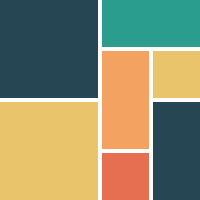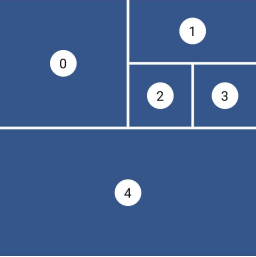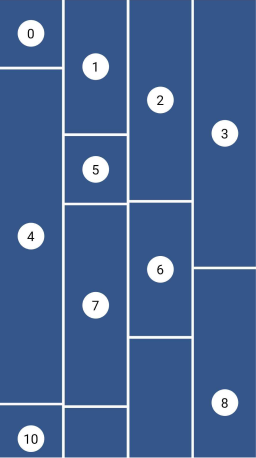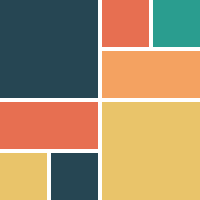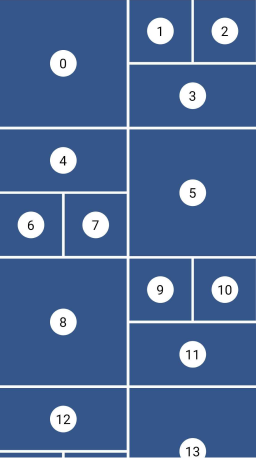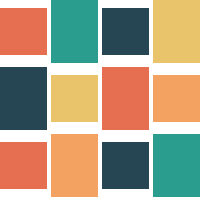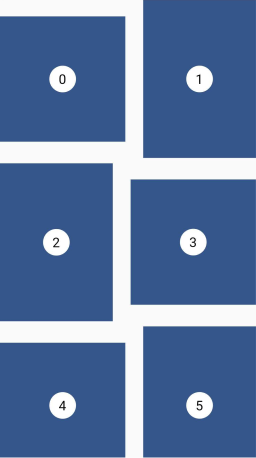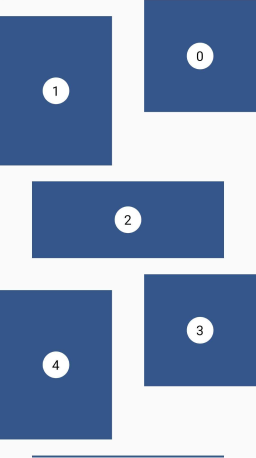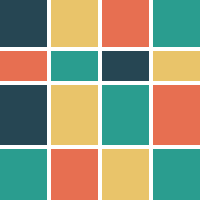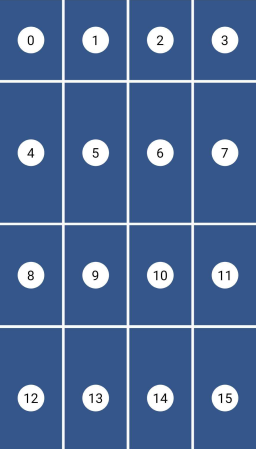Provides a collection of Flutter grids layouts.
In the pubspec.yaml of your flutter project, add the following dependency:
dependencies:
...
flutter_staggered_grid_view: <latest_version>In your library add the following import:
import 'package:flutter_staggered_grid_view/flutter_staggered_grid_view.dart';For help getting started with Flutter, view the online documentation.
This package contains various grid layouts. In the following section, you'll discover each one of them. The explanation of the layout will always considered a top-to-bottom and left-to-right directions to simplify the description. However it is possible to change these directions in the code.
This layout is intended for a small number of items.
I didn't find, for the moment, a performant algorithm which would work in a Sliver context, that's why this is not a GridView and therefore there are no SliverStaggeredGrid.
- Evenly divided in n columns
- Small number of items
- Not scrollable
- Must occupy 1 to n columns
- Top-most and then left-most
Below you'll find the code to create this grid layout:
StaggeredGrid.count(
crossAxisCount: 4,
mainAxisSpacing: 4,
crossAxisSpacing: 4,
children: const [
StaggeredGridTile.count(
crossAxisCellCount: 2,
mainAxisCellCount: 2,
child: Tile(index: 0),
),
StaggeredGridTile.count(
crossAxisCellCount: 2,
mainAxisCellCount: 1,
child: Tile(index: 1),
),
StaggeredGridTile.count(
crossAxisCellCount: 1,
mainAxisCellCount: 1,
child: Tile(index: 2),
),
StaggeredGridTile.count(
crossAxisCellCount: 1,
mainAxisCellCount: 1,
child: Tile(index: 3),
),
StaggeredGridTile.count(
crossAxisCellCount: 4,
mainAxisCellCount: 2,
child: Tile(index: 4),
),
],
);This layout facilitates the browsing of uncropped peer content. Container heights are sized based on the widget size.
This is a complete separate grid and not a SliverGridDelegate for performance reasons. The SliverGrid is great but it needs to have a layout which does not depends on the size of its children. Otherwise we have to compute the size to all children before the end of the cache, which is really not performant for a masonry layout.
- Evenly divided in n columns
- Must occupy 1 column only
- Top-most and then left-most
Below you'll find the code to create this grid layout:
MasonryGridView.count(
crossAxisCount: 4,
mainAxisSpacing: 4,
crossAxisSpacing: 4,
itemBuilder: (context, index) {
return Tile(
index: index,
extent: (index % 5 + 1) * 100,
);
},
);This layout emphasizes certain items over others in a collection. It creates hierarchy using varied container sizes and ratios.
This is a specific delegate for the built-in GridView (or SliverGrid) widget. That's why the example below will create such a layout with a GridView.
- Evenly divided in n columns
- The height of each row is equal to the width of each column
- A pattern defines the size of the tiles and different mode of repetition are possible
- Must occupy 1 to n columns
- Must occupy 1 or more entire rows
- Top-most and then left-most
Below you'll find the code to create this grid layout:
GridView.custom(
gridDelegate: SliverQuiltedGridDelegate(
crossAxisCount: 4,
mainAxisSpacing: 4,
crossAxisSpacing: 4,
repeatPattern: QuiltedGridRepeatPattern.inverted,
pattern: [
QuiltedGridTile(2, 2),
QuiltedGridTile(1, 1),
QuiltedGridTile(1, 1),
QuiltedGridTile(1, 2),
],
),
childrenDelegate: SliverChildBuilderDelegate(
(context, index) => Tile(index: index),
),
);This layout facilitates the browsing of peer content. The items are displayed in containers of varying ratios to create a rhythmic layout.
This is a specific delegate for the built-in GridView (or SliverGrid) widget. That's why the example below will create such a layout with a GridView.
- Evenly divided in n columns
- The height the rows is the maximum height of the tiles
- A pattern defines the size of the tiles
- The size of the tiles follows the pattern in a 'z' sequence.
- The height is defined by an
aspectRatio(width/height) - The width is defined by a
crossAxisRatio(width/column's width) between 0 (exclusive) and 1 (inclusive) - Each tile can define how it is aligned within the available space
- Top-most and then left-most
Below you'll find the code to create this grid layout:
GridView.custom(
gridDelegate: SliverWovenGridDelegate.count(
crossAxisCount: 2,
mainAxisSpacing: 8,
crossAxisSpacing: 8,
pattern: [
WovenGridTile(1),
WovenGridTile(
5 / 7,
crossAxisRatio: 0.9,
alignment: AlignmentDirectional.centerEnd,
),
],
),
childrenDelegate: SliverChildBuilderDelegate(
(context, index) => Tile(index: index),
),
);This layout uses alternating container sizes and ratios to create a rhythmic effect. It's another kind of woven grid layout.
This is a specific delegate for the built-in GridView (or SliverGrid) widget. That's why the example below will create such a layout with a GridView.
- A pattern defines the size of the tiles
- Each tile is shifted from the previous one by a margin in both axis
- The placement follows a 'z' sequence
- The height is defined by an
aspectRatio(width/height) - The width is defined by a
crossAxisRatio(width/available horizontal space) between 0 (exclusive) and 1 (inclusive)
- In a 'z' sequence
Below you'll find the code to create this grid layout:
GridView.custom(
gridDelegate: SliverStairedGridDelegate(
crossAxisSpacing: 48,
mainAxisSpacing: 24,
startCrossAxisDirectionReversed: true,
pattern: [
StairedGridTile(0.5, 1),
StairedGridTile(0.5, 3 / 4),
StairedGridTile(1.0, 10 / 4),
],
),
childrenDelegate: SliverChildBuilderDelegate(
(context, index) => Tile(index: index),
),
);This layout is also called CSS Grid. This is a common grid layout on the web, where each item within a track has the maximum cross axis extent of its siblings.
- Evenly divided in n columns
- The rows can have differents heights
- Must occupy 1 column only
- Each tile has the same height as the tallest one of the row.
- Top-most and then left-most
Below you'll find the code to create this grid layout:
AlignedGridView.count(
crossAxisCount: 4,
mainAxisSpacing: 4,
crossAxisSpacing: 4,
itemBuilder: (context, index) {
return Tile(
index: index,
extent: (index % 7 + 1) * 30,
);
},
);I'm working on my packages on my free-time, but I don't have as much time as I would. If this package or any other package I created is helping you, please consider to sponsor me so that I can take time to read the issues, fix bugs, merge pull requests and add features to these packages.
I want to thank Tommy for sponsoring this package. Thanks to him, I took the time to investigate in the previous performance issues and refactor this library to make it how is it today.
Tom3652 |
Feel free to contribute to this project.
If you find a bug or want a feature, but don't know how to fix/implement it, please fill an issue.
If you fixed a bug or implemented a feature, please send a pull request.



